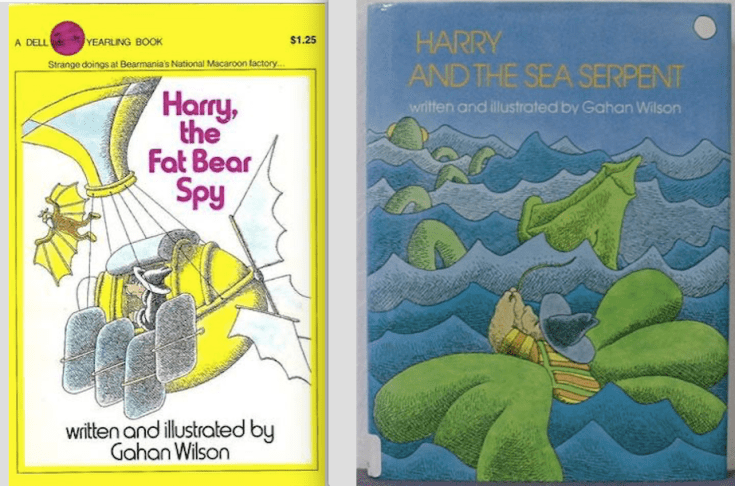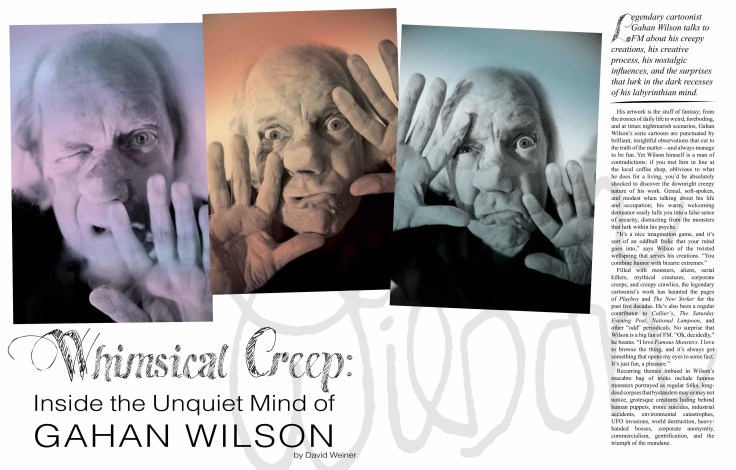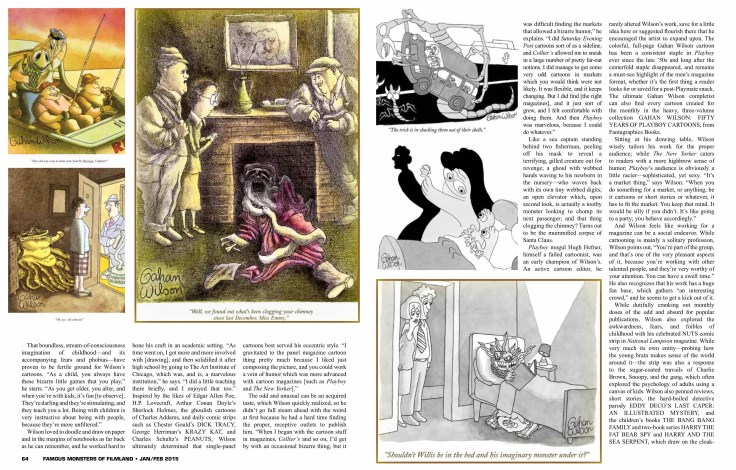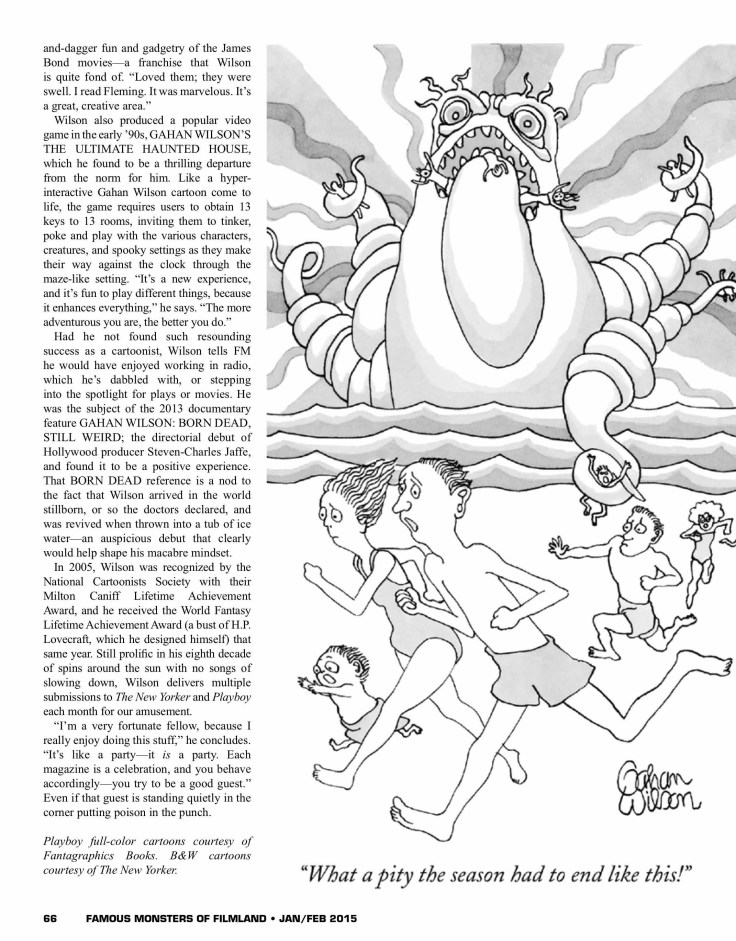People like to joke that they read Playboy for the articles. I read Playboy for the Gahan Wilson cartoons.
And then the Playmates.

When I was a kid, my dad worked in advertising and always had a huge pile of magazines stashed in various locations around the house. Many of those magazines were Playboys, and in the course of sneaking a peek when the folks weren’t around, I genuinely found myself first seeking out Wilson’s weird, whimsical and downright creepy crawly cartoons.
Around the same time, I enjoyed reading Wilson’s brief foray into children’s books with Harry, The Fat Bear Spy and Harry and the Sea Serpent.

I have always been a huge fan of Wilson’s morbid wit and distinct drawing style, and when I was first writing for Famous Monsters of Filmland magazine, I pitched a Wilson interview article, not even knowing if I’d be able to track him down. Fully expecting to be shot down, I was pleasantly surprised when then-executive editor Ed Blair simply said, “Sure! His stuff is great.”
I did indeed track down the then-84-year-old Wilson at his home in Sag Harbor, New York, and enjoyed picking his brain about the macabre and twisted cartoons he created that amused countless readers of The New Yorker, Playboy, and National Lampoon. It was a personal victory for me to say that I got to interview one of the creative heroes of my childhood. He was a wonderful chat.
I just learned that Wilson had died on November 21 at the age of 89. My heart sunk.
I immediately went to his extensive, three-volume collection, Gahan Wilson: Fifty Years of Playboy Cartoons, and had several hearty chuckles. Then I unearthed my Famous Monsters interview to share with all of you. (the article first, the easier-to-read copy below that).
RIP, Gahan Wilson. You were the ultimate whimsical creep who made so many smile.




Whimsical Creep: Inside the Unquiet Mind of Gahan Wilson
Legendary cartoonist Gahan Wilson talks to FM about his creepy creations, his creative process, his nostalgic influences, and the surprises that lurk in the dark recesses of his labyrinthian mind.
By David Weiner
His artwork is the stuff of fantasy; from the ironies of daily life to weird, foreboding, and at times nightmarish scenarios, Gahan Wilson’s eerie cartoons are punctuated by brilliant, insightful observations that cut to the truth of the matter — and always manage to be fun. Yet Wilson is a man of contradictions; if you met him in line at the local coffee shop, oblivious to what he does for a living, you’d be absolutely shocked to discover the downright creepy nature of his work. Genial, soft-spoken and modest when talking about his life and occupation, his warm, welcoming demeanor easily lulls you into a false sense of security, distracting from the monsters that lurk within his psyche.
“It’s a nice imagination game, and it’s sort of an oddball frolic that your mind goes into,” says Wilson of the twisted wellspring that serves his creations. “You combine humor with bizarre extremes.”
Filled with monsters, aliens, serial killers, mythical creatures, corporate creeps and creepy crawlies, the legendary cartoonist’s work has haunted the pages of PLAYBOY and THE NEW YORKER for the past five decades. He’s also been a regular contributor to Collier’s, The Saturday Evening Post, NATIONAL LAMPOON, and other “odd” periodicals. No surprise, Wilson is a big fan of FM. “Oh, decidedly,” he beams. “I love Famous Monsters. … I love to browse the thing, and it’s always got something that opens my eyes to some fact. It’s just fun, a pleasure.”
Recurring themes imbued in Wilson’s macabre bag of tricks include famous monsters portrayed as regular folks; long-dead corpses that bystanders may or may not notice; grotesque creatures hiding behind human puppets; ironic suicides; industrial accidents; environmental catastrophes; UFO invasions; world destruction; heavy-handed bosses; corporate anonymity; commercialism; gentrification; and the triumph of the mundane.
Talking to us from his home in Sag Harbor, NY, Wilson, now 84, was happy to provide a glimpse — via an old, creaky trap door, perhaps? — into the creative maelstrom swirling in his brain. “It comes naturally,” he says with modest simplicity. “That spooky thing amused me. [My cartoons are] rather touching, too, because it’s all about vulnerability, and the images are, in a funny way, a kindly kind of amusement.”
So where does all that dark whimsy stem from? A true nostalgic sort, Wilson gets a twinkle in his eye when he thinks about his Depression-era childhood and formative years. “I read WEIRD TALES, and so on… I was inclined from the get-go to fantasies, and I loved pulp magazines and that kind of stuff, and the movies,” he says. “We did all sorts of cowboy, bang-bang sorts of things… I didn’t see actual horror movies as a wee child, but I took to them when I was able to see the darn things, and enjoyed them from the start. … I’m quite a movie buff, and I just adore the classics of that marvelous Karloff/Lugosi period. They were swell movies. They still are swell movies. … I remember realizing I was rather affectionate towards the Frankenstein Monster, and realized later on that it was because these people [who crafted the movie] were skillful. [FRANKENSTEIN] is a marvelous fable.”
The classic creatures and characters that populated those “swell movies” regularly inhabit Wilson’s work, albeit with a twist. Frankenstein’s Monster becomes the equivalent of a stray dog picked up by enthusiastic trick-or-treaters, only to be rebuffed by their parents: “I don’t care if he did follow you home—you can’t keep him.” Dracula sprinkles a shaker of salt with delight on the neck of his next victim, or shudders with fear outside of a movie theater showing “VON HELSING,” his family recoiling in horror at the poster that promises a stake-wielding “Fiend Who Comes at Dawn.” And a portrait artist bristles with anticipation of the full moon so he can finish his painting of The Wolf Man.
Reflecting on how he initially chose to pursue such left-of-center subject matter that still connects with the veracity of the moment, he observes, “As you get older, you get wiser, and you learn about what’s actually happening in real life. It connects with the creations, as with any art. … I think I was pretty much slanted; I liked the fantastic feel, and I did enjoy the spooky stuff. I felt very comfortable and had fun with it. It’s got a nice, rather touching history to it all.”
Wilson grew up in Evanston, IL, a densely populated suburban landscape just north of downtown Chicago. A college town (it’s home to Northwestern University) peacefully perched on the shores of Lake Michigan, the clean and slightly timeless location provided a pleasant Midwest foundation for the artist. “My father worked for this big business company, and did really well, got higher and higher and so on. I look back on it with pleasure,” he recalls. “We lived in an apartment building, one of these middle-class kind of operations, and then later on, as things got better and better, we moved on from there, but it was a nice setup. It had just ordinary, middle-class folk, and lots of kids, so we played the kid fantasy games, which they still do. I get a little teary-eyed, sometimes, seeing them run around, doing some fantasizing.”
That boundless, stream-of-consciousness imagination of childhood — and its accompanying fears and phobias — have proven to be fertile ground for Wilson’s cartoons. “As a child, you always have these bizarre little games that you play,” he starts. “As you get older, you alter, and when you’re with kids, it’s fun [to observe]. They’re darling and they’re stimulating, and they teach you a lot. Being with children is very instructive about being with people, because they’re more unfiltered.”
Wilson loved to doodle and draw on paper and in the margins of notebooks as far back as he can remember, and he worked hard to hone his craft in an academic setting. “As time went on, I got more and more involved with [drawing], and then solidified it after high school by going to The Art Institute of Chicago, which was, and is, a marvelous institution,” he says. “I did a little teaching there briefly and I enjoyed that too.” Inspired by the likes of Edgar Allen Poe, H.P. Lovecraft, Arthur Conan Doyle’s Sherlock Holmes, the ghoulish cartoons of Charles Addams, and daily comic strips such as Chester Gould’s DICK TRACY, George Herriman’s KRAZY KAT, and Charles Schultz’s PEANUTS, Wilson ultimately determined that single-panel cartoons best served his eccentric style: “I gravitated to the panel magazine cartoon thing pretty much because I liked just composing the picture, and you could work a vein of humor which was more advanced with the cartoon magazines [such as PLAYBOY and THE NEW YORKER].”
The odd and unusual can be an acquired taste, which Wilson quickly realized, so he didn’t go full steam ahead with the weird at first because he had a hard time finding the proper, receptive outlets to publish him: “When I began with the cartoon stuff in magazines, COLLIER’S and so on, I’d get by with an occasional bizarre thing, or bizarre-ish, but the markets that bought stuff that allowed a bizarre humor, it was difficult finding them,” he explains. “I did Saturday Evening Post cartoons sort of as a sideline, and COLLIER’S allowed me to sneak in a large number of pretty far-out notions. I did manage to get some very odd cartoons in markets which you would think were not likely, but it’s flexible and it keeps changing. It’s interesting how it does. … But I did find [the right magazines], and it just sort of grew, and I felt comfortable with it. And then PLAYBOY’s marvelous, because I could do whatever.”
Like a sea captain standing behind two fisherman peels off his mask to reveal a terrifying, gilled creature out for revenge; a ghoul with webbed hands waving to his newborn in the nursery — who waves back with its own tiny webbed digits; an open elevator, upon second look, is actually a toothy monster looking to chomp its next passenger; and that thing clogging the chimney? Turns out to be the mummified corpse of Santa Claus.
PLAYBOY mogul Hugh Hefner, himself a failed cartoonist, was an early champion of Wilson’s. An active cartoon editor, he rarely altered Wilson’s work, save for a little idea here or suggested flourish there that he encouraged the artist to expand upon. The colorful, full-page Gahan Wilson cartoon has been a consistent staple in PLAYBOY ever since the late ‘50s — long after the centerfold staple disappeared — and remains a must-see highlight of the men’s magazine format, whether it’s the first thing a reader looks for, or is saved for a post-Playmate snack. The ultimate Gahan Wilson completist can also find every cartoon created for the monthly in the heavy, three-volume collection Gahan Wilson: Fifty Years of Playboy Cartoons, from Fantagraphics Books.
Sitting at his drawing table, Wilson wisely tailors his work for the proper audience; while THE NEW YORKER caters to readers with a more highbrow sense of humor; PLAYBOY’s audience is obviously a little racier — sophisticated, yet sexy. “It’s a market thing,” says Wilson. “When you do something for a market, or anything, be it cartoons or short stories or whatever, it has to fit the market. You keep that mind. It would be silly if you didn’t. It’s like going to a party; you behave accordingly.”
And Wilson feels like working for a magazine can be a social endeavor. While cartooning is mainly a solitary profession, Wilson points out, “You’re part of the group, and that’s one of the very pleasant aspects of it, because you’re working with other talented people, and they’re very worthy of your attention. You can have a swell time.” He also recognizes that his work has a huge fan base, which gathers “an interesting crowd,” and he seems to get a kick out of it.
While dutifully cranking out monthly doses of the odd and absurd for popular publications, Wilson also explored the awkwardness, fears and foibles of childhood with his celebrated NUTS comic strip in NATIONAL LAMPOON magazine. While very much its own entity, probing how the young brain makes sense of the world around it, the strip was also response to the sugar-coated travails of Charlie Brown, Snoopy and the gang, which often explored the psychology of adults using a canvas of kids. Wilson also penned reviews, short stories, the hard-boiled detective parody EDDY DECO’S LAST CAPER: AN ILLUSTRATED MYSTERY, and the children’s books THE BANG BANG FAMILY and two-book series HARRY THE FAT BEAR SPY and HARRY AND THE SEA SERPENT, which draw on the cloak-and-dagger fun and gadgetry of the James Bond movies — a franchise that Wilson is quite fond of. “Loved them; they were swell. I read Fleming. It was marvelous, the whole fantasy thing. It’s a great, creative area that really is fun.”
Wilson also produced a popular video game in the early ‘90s, GAHAN WILSON’S THE ULTIMATE HAUNTED HOUSE, which he found to be a thrilling departure from the norm for him. Like a hyper-interactive Gahan Wilson cartoon come to life, the game requires users to obtain 13 keys to 13 rooms, inviting them to tinker, poke and play with the various characters, creatures and spooky settings as they make their way against the clock through the maze-like setting. “It’s a new experience, and it’s fun to play different things, because it enhances everything,” he says. “The more adventurous you are, the better you do.”
Had he not found such resounding success as a cartoonist, Wilson tells FM he would have enjoyed working in radio, which he’s dabbled with, or stepping into the spotlight for plays or movies. He was the subject of the 2013 documentary feature, GAHAN WILSON: BORN DEAD, STILL WEIRD, the directorial debut of Hollywood producer Steven-Charles Jaffe, and found it to be a positive experience. That BORN DEAD reference is a nod to the fact that Wilson arrived in the world stillborn, or so the doctors declared, and was revived when thrown into a tub of ice water — an auspicious debut that clearly would help shape his macabre mindset.
In 2005, Wilson was recognized by the National Cartoonists Society with their Milton Caniff Lifetime Achievement Award, and he received the World Fantasy Lifetime Achievement Award (a bust of H.P. Lovecraft, which he designed himself) that same year. Still prolific in his eighth decade of spins around the sun with no signs of slowing down, Wilson delivers multiple submissions to THE NEW YORKER and PLAYBOY each month for our amusement.
“I’m a very fortunate fellow, because I really enjoy doing this stuff,” he concludes. “It’s like a party — it is a party. Each magazine is a sort of party, a celebration, and you behave accordingly — and you try to be a good guest.” Even if that guest is standing quietly in the corner, putting poison in the punch…
###

Please take a moment to “like” IT CAME FROM… on Facebook and “follow” on Instagram and on Twitter and/or Tumblr for more great retro content.
Then, check out more of my celebrity and filmmaker interviews HERE.
____________________________________________________________________________________
YOU CAN HELP IT CAME FROM BLOG “KEEP THE LIGHTS ON” WITH BUY ME A COFFEE. Thanks!

